splayed & flayed
five roast chickens in five days - a guest post
i am not the only cook in penny’s kitchen
please enjoy the inaugural penny’s kitchen guest post, from mr kitchen himself
Once upon a time I cooked the very excellent "No-Fail Roast Chicken With Lemon and Garlic" from Clair Saffitz. It has since become my duty among friends and family to produce this chicken and its vast volumes of lemony gravy for all special occasions.
The only issue with this recipe is that it produces such a reliably outstanding chicken that ever since I first made, almost 4 years ago, I simply have not been brave enough to branch out and try any other method to roast a chicken, which is a real shame. Not wanting to risk the outcome of a dinner party or Christmas lunch on an untested recipe, I decided to simply roast a bird every night until my curiosity was satisfied.
Chicken number 1: Enclosed roast / Thai red curry
This method flies in the face of the crispy skin ideals by covering the whole roast for the majority of the cooking time.
Cover the base of the roasting vessel with onions, garlic and peeled lemons.
Place the bird atop, then cut the legs so they fall away from the body. Pop a slice of lemon and garlic chunk into the bird.
Smear on the curry paste of choice, reserving a little
Mix the reserved curry paste with water, pepper, chopped kafir lime leaf and fish sauce. Maybe some coconut milk if you are feeling indulgent. Pour around the chicken
Cover with tin foil
Roast at 210 C for 1 hour
Remove cover and roast until lightly coloured and meeting the legal definition of cooked, maybe 15-20 min further.
Remove the chicken, let rest.
While the chicken is resting, prepare the broth from the roasting dish to serve as you wish. This could be as it is, or reduced into a sauce or thickened into a gravy. I found that blending the sauce emulsifies it into a lovely gravy.
Carve the bird, which should be possible with a spoon. Serve with the sauce spooned over.
The two stage covered and uncovered roast seemed to work very well, providing juicy meat and crisp skin with a satisfying roast flavour. The sauce tastes quite logically like a Thai curry made with good chicken stock. The emulsified chicken fat compensated for the very small amount of coconut milk that I added.
Chicken number 2: Spatchcock roast / Miso and scallion
Other than a few pre-marinated chickens for the BBQ, all of my past roasts have been whole, so I was intrigued by the different heat distribution you could achieve by making the whole thing flat.
Start by spatchcocking or butterflying a chicken. I have never done this before, so I followed Kenji’s serious eats YouTube video, which explains the process better than I could. This makes it look like a walk in the park given a sharp pair of kitchen shears, which I can only believe. I had a large knife which made for a much more primal and challenging experience.
Chop enough scallions to line the bottom of a cast iron pan with two layers of large pieces. Add in the chicken on top.
Stuff some butter under the skin, then lube the bird with a neutral oil. Salt and pepper generously. I had some Shichimi Togarashi on hand so that went on too.
Pour in some water, sake and mirin around the chicken to stop the scallions from being annihilated in the oven.
Roast at 210C for about 45 min to one hour or just until done.
Transfer the pan to the stove and burn yourself on the handle. Remove the chicken and let rest.
Add a splash of water, freshly chopped scallions, diced ginger, and a tablespoon of white miso to the pan juices. Whisk to incorporate. Season with soy sauce if needed.
Carve the chicken and serve with a carb of choice, topped with the roast scallions and pan sauce. I used mashed sweet potatoes with miso butter.
This method delivered a well cooked chicken, but the schmaltzy umami laden scallions were the real star of the show.
Chicken number 3: Rack roast / Lemon garlic
A major issue with getting an all-round crisp on a bird is that some part of it is usually sitting in its own juices, leaving the bottom flaccid and pale. Many recipes resolve this by suspending the chicken on a roasting rack to allow air to flow underneath. This also allows vegetables to be placed underneath to cook in the drippings for the adventurous.
I don’t have a roasting rack, so I simply slid an oiled and seasoned bird directly onto the oven rack, with a tray below to catch the drippings. Some lemon and garlic inserted into the cavity helps add flavour.
Roast at 210c for 1 hour or until done.
Slide some tongs or other instrument into the cavity and awkwardly lift the bird out.
Retrieve the drippings tray and use to make a sauce. I combined a few tablespoons of fat and juices with mustard, capers, lemon juice and a clove of garlic roasted in the drippings.
This was a shockingly easy and clean method. I expected to pay a high price for roasting the chicken naked on the oven rack, but cleaning up was easy and viable for a Tuesday night dinner. The all round crisp was impressive but ultimately not that different to a normally roasted chicken. Once the chicken had rested and been carved the crispy bottom skin was soggy but nicely browned.
Chicken number 4: Pot roast / Lemon Za’atar
Having done a pretty average job of approximating a pot roast earlier in the week with the covered roast, I borrowed a cast iron Dutch oven off our neighbour to try to do things properly. The goal here was to disregard the crispy skin ideals completely and focus on universally tender, juicy meat.
Roughly chop an onion, four cloves of garlic, and a peeled lemon or two. Add to a medium sized Dutch oven with a cup of water.
Mix two tablespoons of za’atar, a teaspoon of sumac, quarter teaspoon of allspice, teaspoon of salt, few grinds of pepper with the juice of a lemon and a few teaspoons of olive oil.
Do your best to push this paste under the skin of the bird, then slather the outside with the rest.
Place the chicken in the pot, cover with a lid and bake in a 200c oven until juices run clear (1 hour or longer). Uncover with 15 minutes to go to render some fat.
Shred the chicken into large chunks and add to the pot to cover in sauce. Allow to simmer for a minute or two.
Serve on rice with something acidic, maybe lemon juice or pomegranate molasses, and any fresh mint or parsley you may have lying around.
This method hit the goal of prioritising well cooked meat, but lacked some of the typical “roast chicken” flavour that extended exposure to the dry oven heat usually brings. Penny’s review was that it was a neat way to cook a chicken, but perhaps shouldn’t be promised as a roast chicken at all. Harsh.
Chicken number 5: Return to the rack / Gratin Savoyard
I simply could not get the thought of roasting vegetables below the rack roast chicken out of my head, so it had to be tried.
I thinly sliced a kilogram of potatoes and tossed into a deep oiled sheet pan along with a few cloves of garlic and a shallot. I had the drippings from a previous chicken in the fridge so this was added as well, but adding a few knobs of butter would achieve a similar outcome.
The chicken was simply oiled and salted, with some small pads of butter pushed under the skin. I also cut the legs away from the body and added some crude “drainage holes” below each thigh and next to the spine to ensure maximum dripping action. A cut lemon was stuffed into the cavity for fun as well.
The potatoes are slid onto the bottom rack, with the bird placed on the rack above.
Roast for 45min to an hour depending on bird size. The leg separation will make it cook a bit faster.
The drippings gushed for the whole hour that I baked my bird, resulting in a tray of truly miraculous potatoes but a slightly overcooked chicken (I did my small chook for a full hour, flying too close to the sun. Next time I will cut the cooking time back to the 45 min mark.) Never mind, the chicken was sacrificed for a greater good, with the potatoes being mind-bendingly rich and savoury, despite lacking the usual addition of cream.
After cracking into Jeffrey Steingarten’s second book (It Must've Been Something I Ate, 2002) it is clear to me that what I have created is an extra efficient Gratin Savoyard, a French potato gratin usually made from leftover drippings and broth. The only issue with this method is after donating its juices to the potatoes, the chicken is left without a pan sauce or gravy, which somewhat compromises my usual plans for the bird. Clearly keeping a steady supply of roast drippings on hand is the answer, to allow for both.

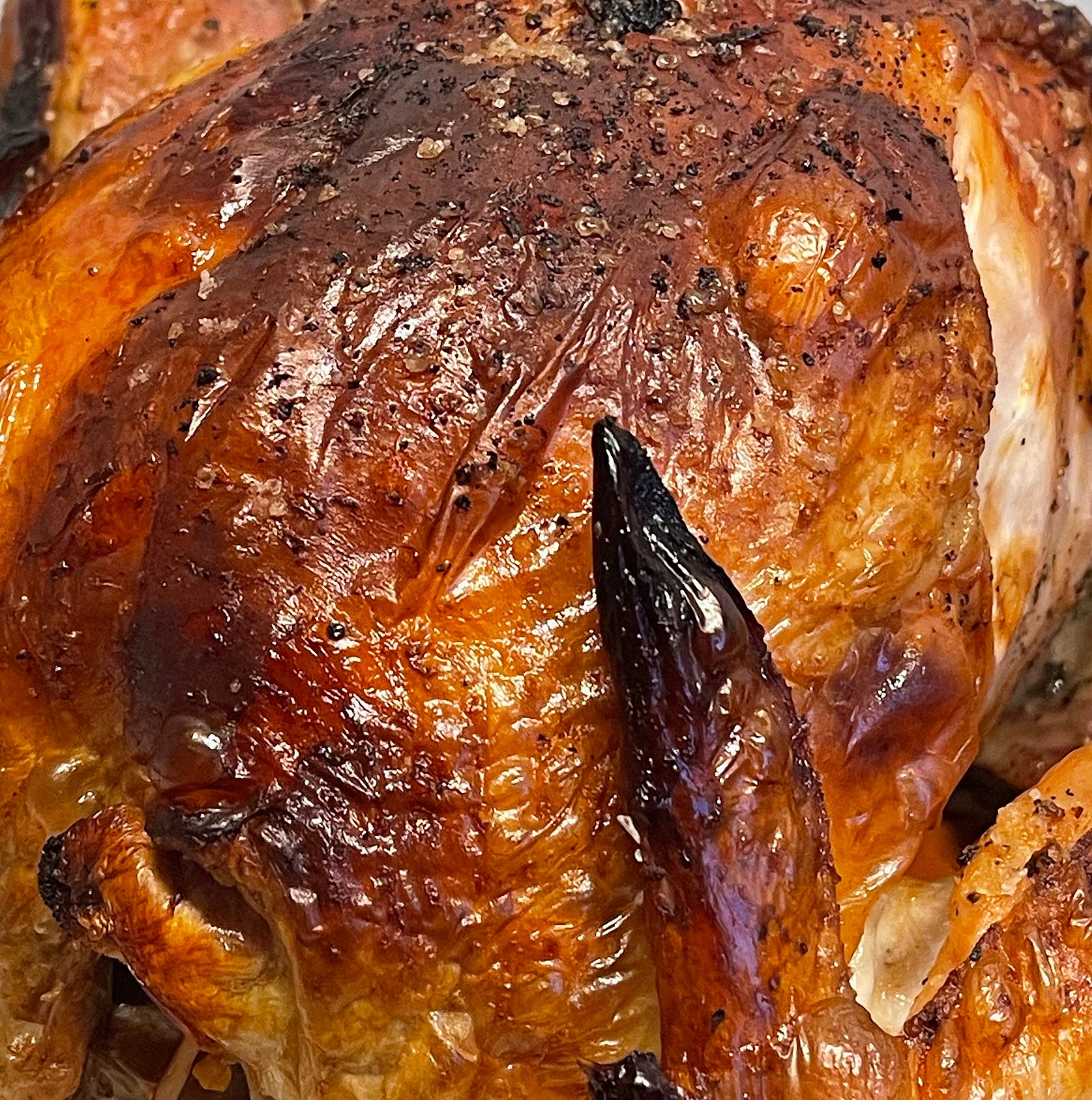
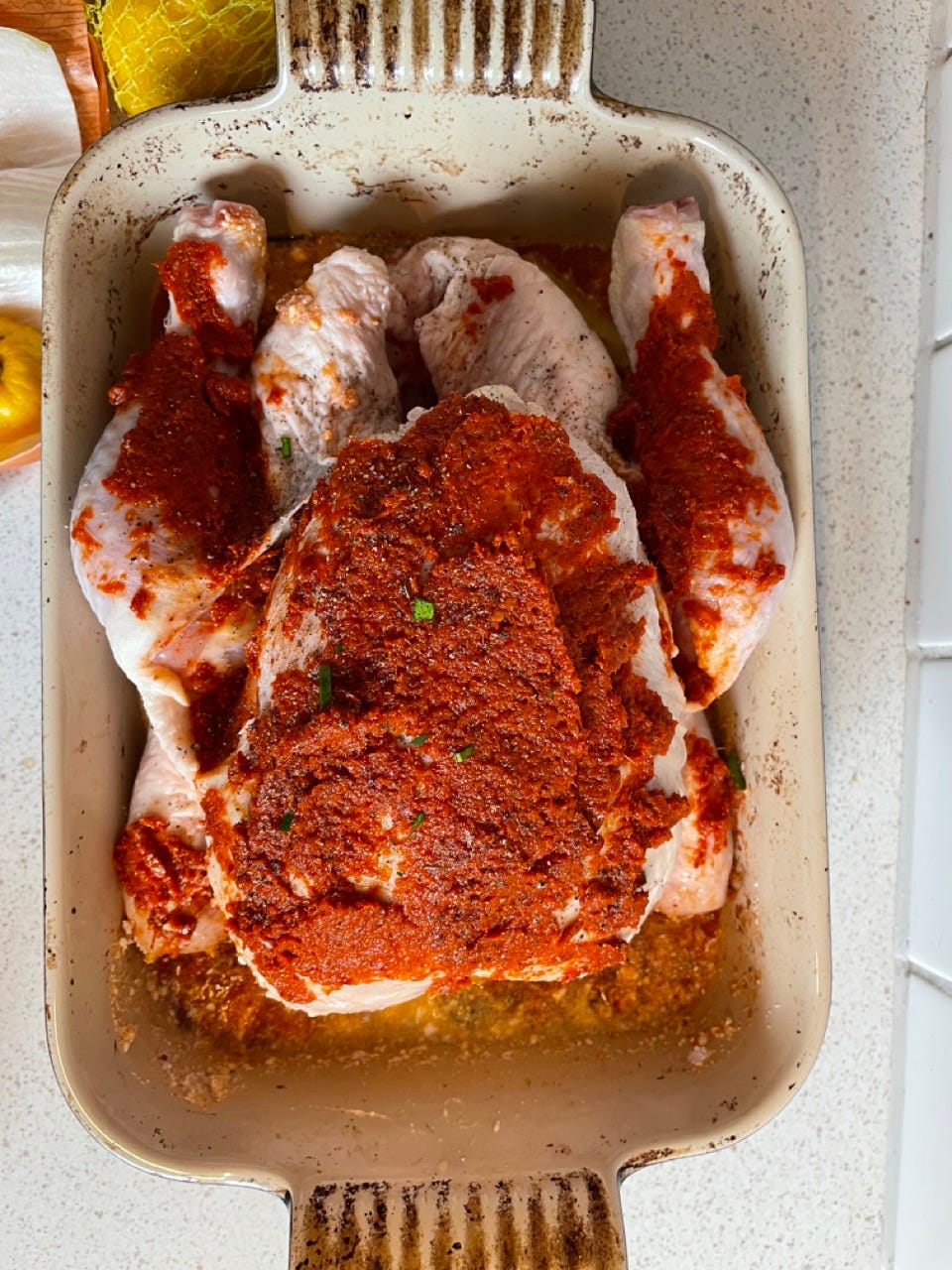
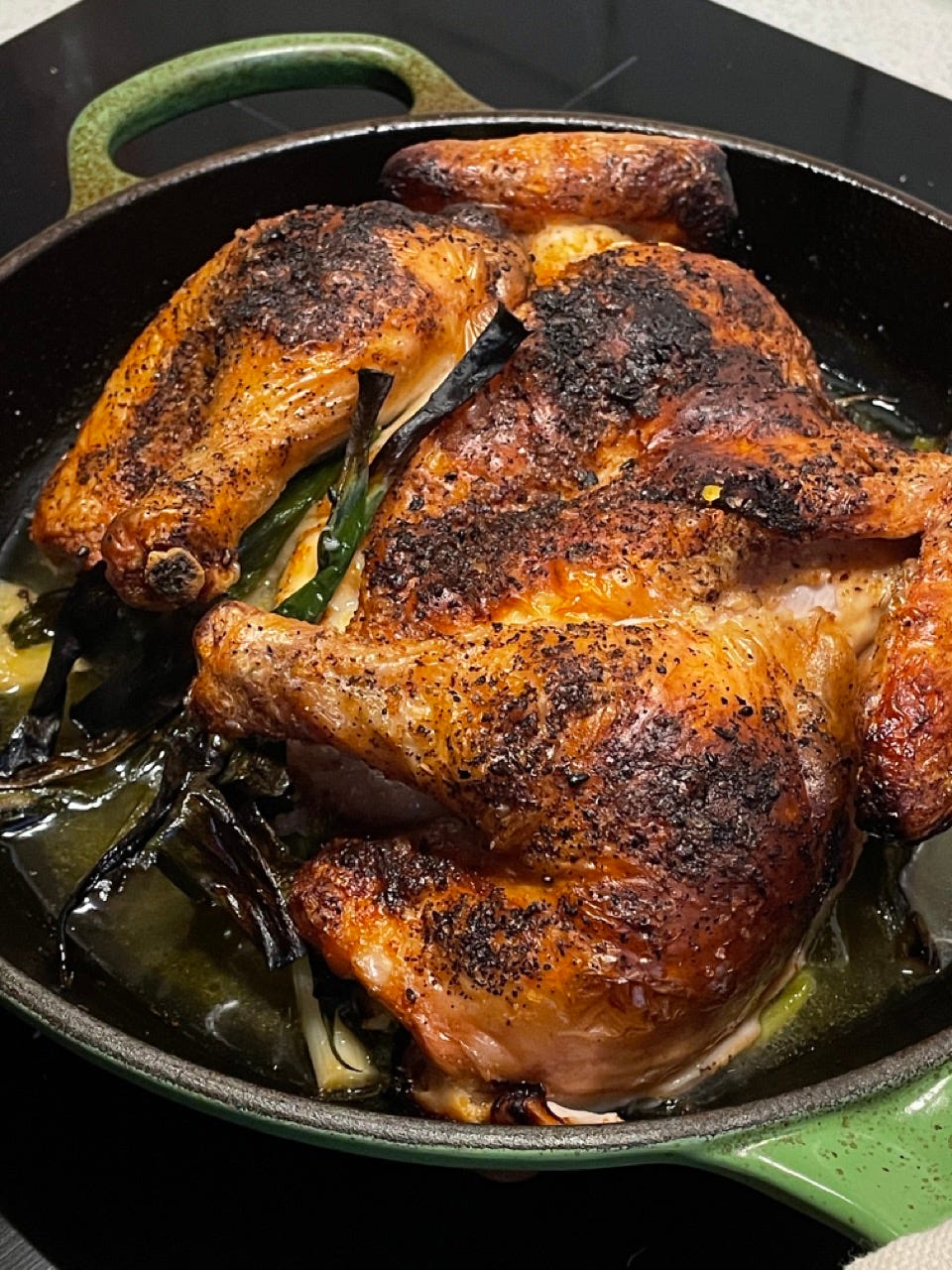
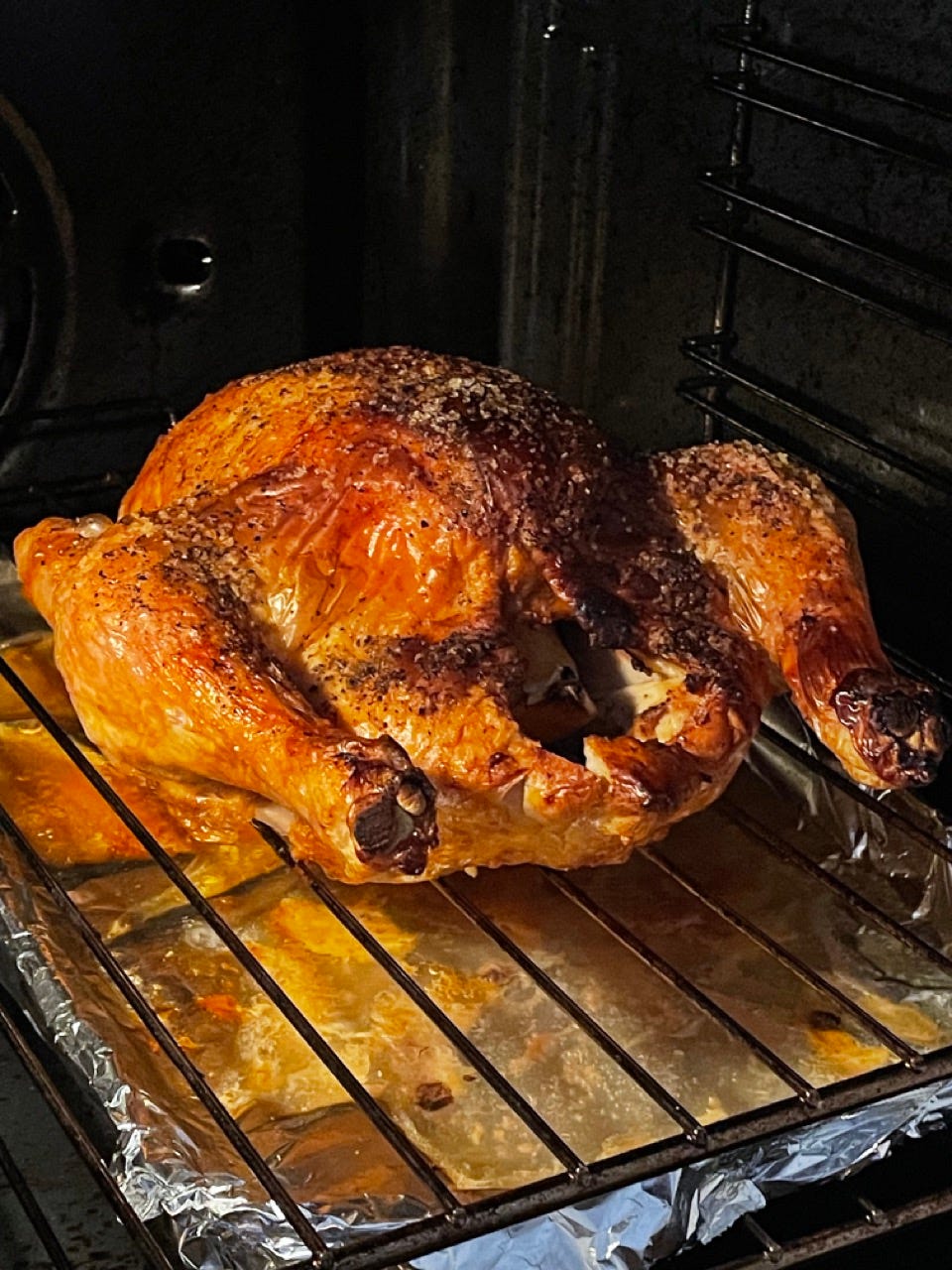
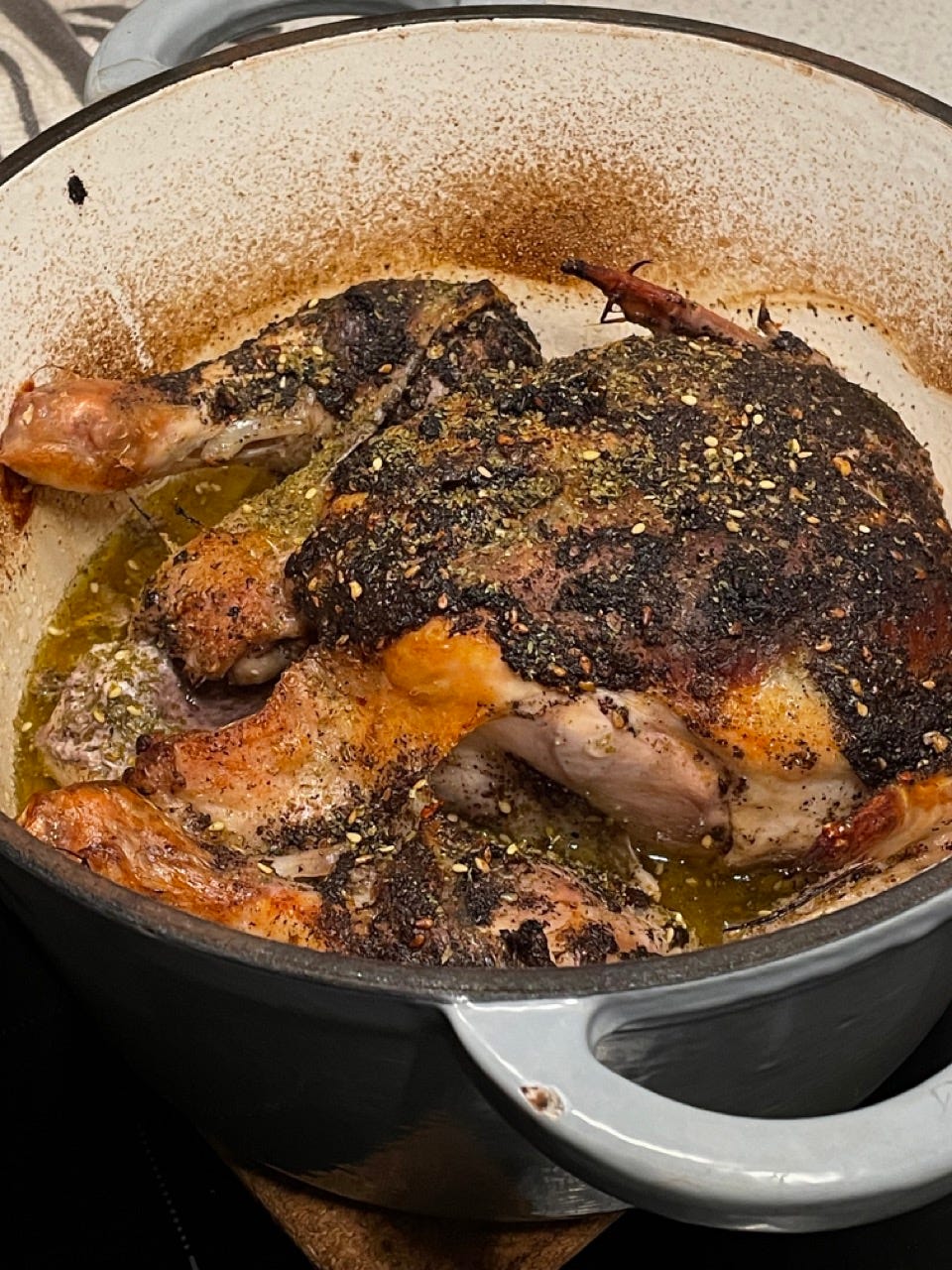
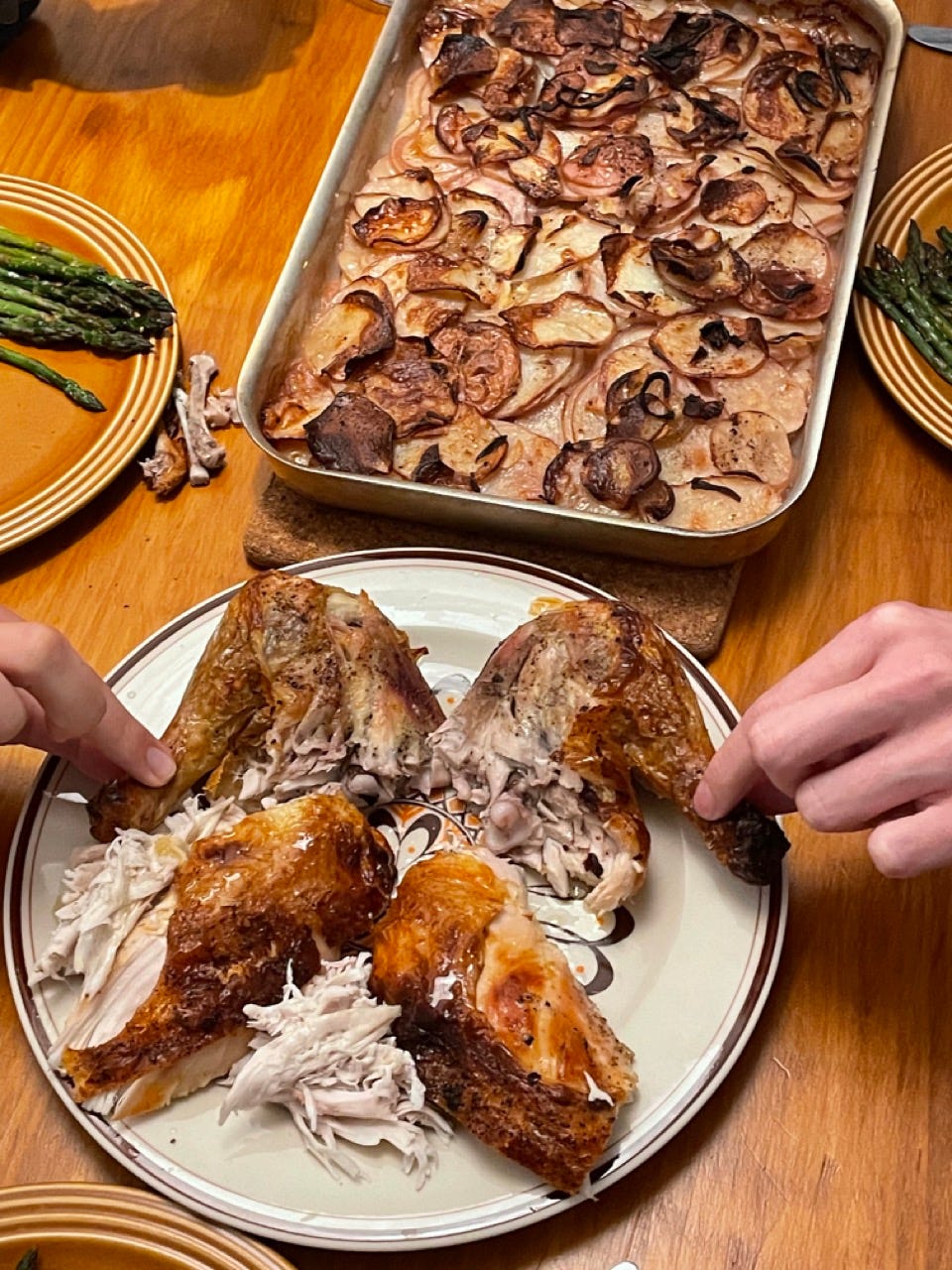
Now I'm hungry...
So, the question we're all wondering. Which was your favourite birdie?